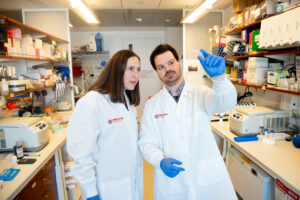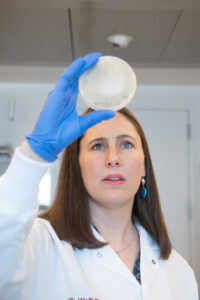Ashley Laughney, PhD ‹ Back To 2024 Winners
2024 Winners
Assistant Professor
Institute for Computational Biomedicine Department of Physiology and Biophysics
Weill Cornell Medicine
Vision
My vision is to tackle the complexities of multimodal protein function, particularly in cancer progression, where activation of the same protein can exhibit diverse roles. Through the development of SatSeq, a pioneering technology that enables mapping of the complete sequence-function landscape of a protein, my lab aims to precisely identify how individual parts of a protein contribute to its various functions and how emerging therapies interact with these elements. Ultimately, SatSeq will be used to advance our understanding of protein function in complex biological systems, facilitate the development of targeted therapies, and improve patient selection for clinical trials.
Ashley Laughney, PhD, is a principal investigator at Weill Cornell Medicine in the Department of Physiology & Biophysics, the Institute for Computational Biomedicine, and the Meyer Cancer Center. With a background in engineering and systems biology, she pioneered functional spectroscopy for cancer detection during her PhD at Dartmouth College. Subsequently, as a postdoctoral fellow at Harvard Medical School and Memorial Sloan Kettering Cancer Center, she developed and applied single-cell imaging and genomics methods for cancer research. Since establishing her independent research program in 2019, her lab integrates single-cell sequencing, high-throughput functional genomics, and computational modeling to elucidate how activation of the very same protein or signaling pathway can lead to diverse cellular responses at different stages of cancer progression. Notably, she is the recipient of numerous NIH/NCI R01 awards and the prestigious Burroughs Wellcome Fund Career Award at the Scientific Interface (CASI).
SatSeq: a scalable platform to effectively target multi-modal proteins in cancer

Proteins are highly versatile – orchestrating many functions across diverse biological processes; often through the evolution of distinct domains (or parts). Thus, predicting protein function from sequence represents one of biology’s most intractable challenges. Now imagine being able to unravel the mysteries encoded within a protein’s sequence in a single reaction – mapping each building block (or amino acid) to a specific function or drug binding event. Behold SatSeq! A modular breakthrough technology we have developed that couples the power of single cell sequencing with saturation mutagenesis and DNA barcoding – to map each part of a protein to various functions and drug binding events.
“Understanding protein function in cancer is complex due to its varied effects on cellular responses. The Pershing Square Sohn Prize will allow my lab to develop an innovative technology aimed at mapping the multiple functions of a protein as cancer advances, improving our ability to effectively target these processes.”

We innovated SatSeq to interrogate the opposing functions of an immune-related protein called Stimulator of Interferon Genes (STING) in cancer progression – a protein that has been shown to activate anti-tumor immunity early in disease progression, but can later drive metastasis (the lethal spread of cancer). We hypothesize that this duality is achieved through distinct functional elements. Herein, we propose using SatSeq to (1) map the functions encoded by each part of STING protein and how they contribute to the development and spread of cancer, and (2) evaluate how drugs interact with these functional elements – revealing exactly where emerging STING-directed therapies bind, what functions they disrupt, and specific patient populations most likely to respond. Furthermore, it will reveal the context in which STING activation versus inhibition is therapeutically viable, so that we may better select patients that would benefit from emerging small molecule activators and inhibitors in clinical development.
“I love developing systems-level approaches that are hypothesis-driven and inspired by biology. I believe innovation emerges through meaningful integration of concepts and tools across disciplines; of course, coupled with the development of rigorous systems to test and refine established notions.”